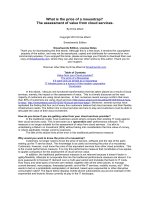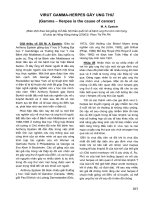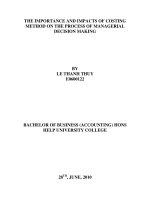topics retrosynthesis Retrosynthesis is the process of “deconstructing” a target molecule into readily available starting materials by means of
Bạn đang xem bản rút gọn của tài liệu. Xem và tải ngay bản đầy đủ của tài liệu tại đây (452.08 KB, 12 trang )
Dr. P. Wipr
Chem 2320
4/16/2007
III-A. RETROSYNTHETIC ANALYSIS
Definitions
• Disconnection: An analytical operation, which breaks a bond
and converts a molecule into a possible starting material. The
reverse of a chemical reaction. Symbol ⇒ and a curved line
drawn through the bond being broken.
• FGI: Functional Group Interconversion: The operation of writing one
functional group for another so that disconnection becomes possible. The
reverse of a chemical reaction. Symbol ⇒ with FGI written over it.
• Reagent: A compound which reacts to give an intermediate in the
planned synthesis or to give the target molecule itself. The synthetic
equivalent of a synthon.
• Synthetic equivalent: A reagent carrying out the function of a synthon
which cannot itself be used, often because it is too unstable.
•Synthon: A generalized fragment, usually an ion, produced by a
disconnection. (some people also use synthon for a synthetic equivalent).
•Target Molecule: The molecule whose synthesis is being planned.
1
Dr. P. Wipr
Chem 2320
4/16/2007
Retrosynthesis
Retrosynthesis is the process of “deconstructing” a target
molecule into readily available starting materials by means of
- imaginary breaking of bonds (disconnections) and by the conversion of
one functional group into another (functional group interconversions).
The following factors need be taken into consideration:
Efficiency, e.g. the “arithmetic demon”:
“The arithmetic demon dictates one of the major axioms of synthesis: Get
the most done in the fewest steps and in the highest yield.” (R. E.
Ireland)
A linear synthesis with 14 starting materials and intermediates:
yield = (0.8)14 = 4%
2
Dr. P. Wipr
Chem 2320
4/16/2007
A convergent synthesis with 14 starting materials and
intermediates:
yield = (0.8)3 = 51%
Question: If every reaction goes with a 60% yield, what is the
more efficient strategy:
or
????????????????
3
Dr. P. Wipr
Chem 2320
4/16/2007
Carpanone: Chapman, O. et al. J. Am. Chem. Soc. 1971, 93,
6696.
4
Dr. P. Wipr
Chem 2320
4/16/2007
Mechanism:
5
Dr. P. Wipr
Chem 2320
4/16/2007
6
Dr. P. Wipr
Chem 2320
4/16/2007
7
Dr. P. Wipr
Chem 2320
4/16/2007
8
Dr. P. Wipr
Chem 2320
4/16/2007
9
Dr. P. Wipr
Chem 2320
4/16/2007
10
Dr. P. Wipr
Chem 2320
4/16/2007
11
Dr. P. Wipr
Chem 2320
4/16/2007
12









